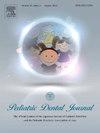Prevalence of molar-incisor hypomineralization in Mexican population: A systematic review and meta-analysis
IF 0.8
Q4 DENTISTRY, ORAL SURGERY & MEDICINE
引用次数: 0
Abstract
Background
Molar-incisor hypomineralization (MIH) is a qualitative defect in enamel formation with a multifactorial etiology. Studies indicate a high prevalence of MIH across the Americas, yet the prevalence in Mexico remains uncertain.
Aim
This study aimed to review the literature on the prevalence of MIH in the Mexican population and its associated factors.
Methods
Six electronic databases were searched for relevant studies: PubMed, Scopus, Dentistry & Oral Science, Science Direct, Web of Science, and Google Scholar, covering the period from March 10th, 2024. Cross-sectional studies were assessed for risk of bias using the Joanna Briggs Institute (JBI) tool.
Results
Nine studies met the inclusion criteria, encompassing 5039 children aged 6–12 years, with a mean age of 9.02 ± 1.19 years; 50.1% were boys, and 49.9% were girls. The overall prevalence of MIH was 23%, with a higher prevalence in boys (34.1%) than in girls (30.4%). MIH was more common in molars (30.7%) than in incisors (10.8%), with no cases reported in permanent second molars. Five studies (55.5%) noted dental caries in MIH-affected individuals, with 78.7% showing caries and 21.3% caries-free. The JBI analysis found 33.3% of studies with moderate risk and 66.7% with low risk of bias.
Conclusion
The prevalence of MIH in Mexico aligns with rates reported in Brazil and Venezuela. The evidence indicates no significant gender differences in MIH distribution, with molars being more frequently affected than incisors. A substantial proportion of Mexican children with MIH also present with dental caries.
墨西哥人群中磨牙-门牙低矿化的患病率:一项系统回顾和荟萃分析
背景磨牙-切牙低矿化(MIH)是一种釉质形成缺陷,具有多因素病因。研究表明,MIH在美洲的流行率很高,但墨西哥的流行率仍不确定。目的本研究旨在回顾墨西哥人群中MIH患病率及其相关因素的文献。方法检索PubMed、Scopus、Dentistry &;Oral Science, Science Direct, Web of Science, b谷歌Scholar,覆盖时间从2024年3月10日开始。使用乔安娜布里格斯研究所(JBI)工具评估横截面研究的偏倚风险。结果9项研究符合纳入标准,共纳入5039例6 ~ 12岁儿童,平均年龄9.02±1.19岁;男生占50.1%,女生占49.9%。MIH的总患病率为23%,其中男孩(34.1%)高于女孩(30.4%)。磨牙(30.7%)比门牙(10.8%)更常见,恒磨牙(10.8%)无病例报道。5项研究(55.5%)发现mih患者有龋齿,其中78.7%有龋齿,21.3%没有龋齿。JBI分析发现33.3%的研究具有中等偏倚风险,66.7%的研究具有低偏倚风险。结论墨西哥的MIH患病率与巴西和委内瑞拉报告的患病率一致。证据表明,MIH的性别分布没有显著差异,磨牙比门牙更容易受到影响。相当一部分患有MIH的墨西哥儿童还患有龋齿。
本文章由计算机程序翻译,如有差异,请以英文原文为准。
求助全文
约1分钟内获得全文
求助全文
来源期刊

Pediatric Dental Journal
DENTISTRY, ORAL SURGERY & MEDICINE-
CiteScore
1.40
自引率
0.00%
发文量
24
审稿时长
26 days
 求助内容:
求助内容: 应助结果提醒方式:
应助结果提醒方式:


